Mongolia 2023 "Ice Age Animals"
| <prev | back to index | next> |
| Issue Date | 21.12.2023 |
| ID | Michel: Scott:, Stanley Gibbons: , Category: pR |
| Designer | B. Bayarkhu |
| Stamps in set | 4 |
| Value |
1500 MNT - Bison priscus (Steppe Bison) 1500 MNT - Mammuthus primigenius (Woolly Mammoth) 1500 MNT - Struthio anderssoni (East Asian ostrich) 1500 MNT - Coledonta anntiquuitatis (Wooly Rhinoceros) |
| Emission/Type | commemorative |
| Issue place | Ulaan-Baatar |
| Size (width x height) | Stamp size: 35mm x 35mm, Mini-Sheet size: 105 x 145mm |
| Layout | Mini-Sheet with 4 stamps |
| Products | FDC x 1 |
| Paper | |
| Perforation | (available as imperforate too) |
| Print Technique | 4 colors, offset lithography |
| Printed by | |
| Quantity | Mini-Sheets (perforated) 10.000, FDC 1.111 |
| Issuing Authority | Mongol Post Company |

On December 21st, 2023, the Post Authority of Mongolia in collaboration with the Institute of Paleontology of the Mongolian Academy of Sciences, issued the Mini-Sheet with 4 stamps "Ice Age Animals".
This time, it was cheaper to purchase these stamps and FDC from dealers on the Internet, rather than to order them directly from the Mongolian Post online store. The perforated Mini-Sheet was offered to the foreign customers, in the online store for USD 6, but some dealers offered it for USD 4, while the face value of the Mini-Sheet of 6,000 MNT was equivalent to USD 1.75 only.
Mongolian customers were able to purchase it for the face value. The imperforate Mini-Sheet wasn't offered in the online store at all.
Mongolia was one of the first countries to issue stamps of dinosaurs and prehistoric mammals (1967). Since than the county issues stamps of prehistoric animals regularly. However, the "Ice Age Animals" stamps are the first Mongolian stamps shown in cave/rock paintings created by prehistoric people.
The paintings and reconstructions of the following four Ice Age Animals were depicted on the stamps from the Mini-Sheet.
The steppe bison, Bison priscus
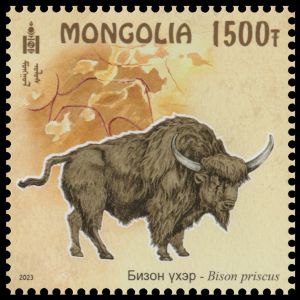 |
| Bison priscus (the Steppe Bison) on stamp of Mongolia 2023 MiNr.: , Scott: |
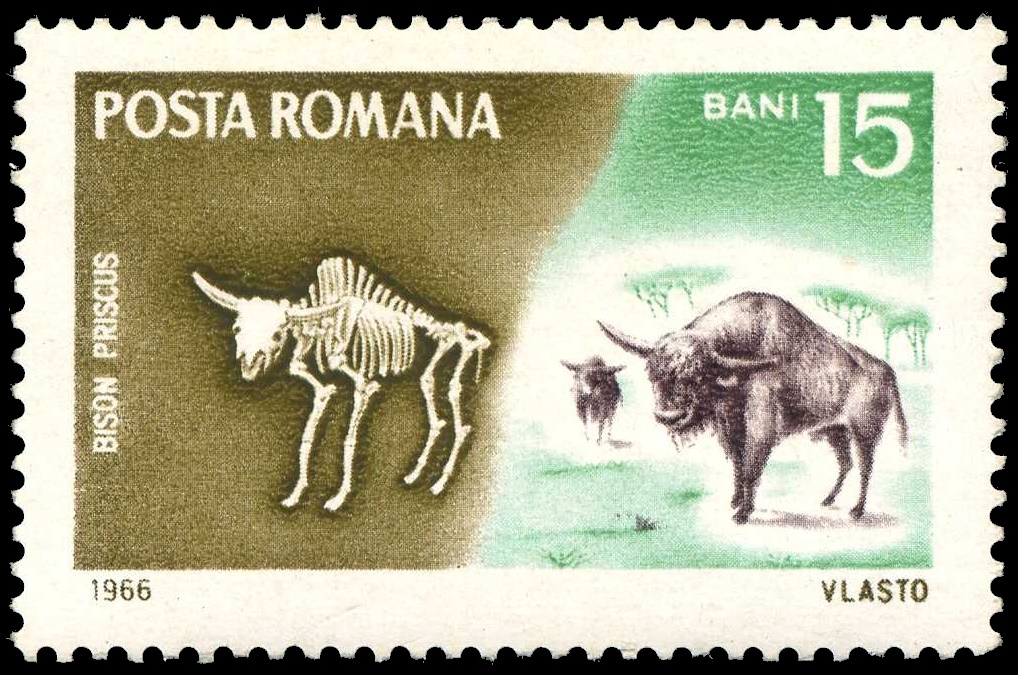 |
| The first stamp of Bison priscus (the Steppe Bison) - Romania 1966 MiNr.: 2555, Scott: 1889. |
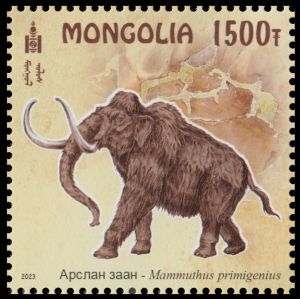 |
| Woolly mammoth (Mammuthus primigenius) on stamp of Mongolia 2023 MiNr.: , Scott: |
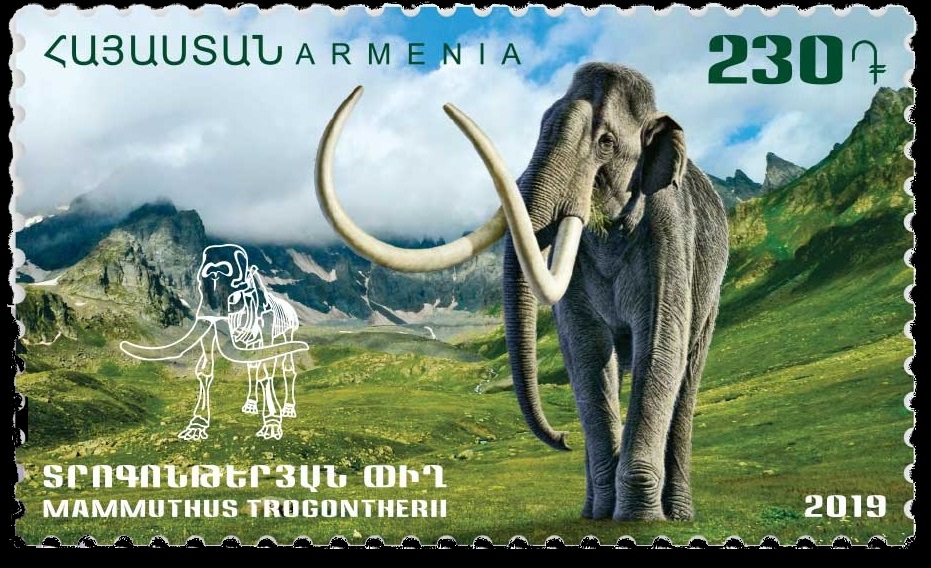 |
| The steppe mammoth (Mammuthus trogontherii) on stamp of Armenia 2023 MiNr.: 1112, Scott: 1184. |
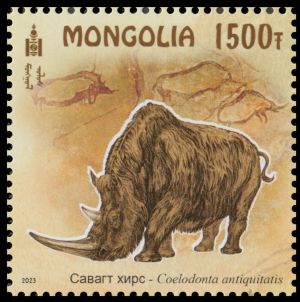 |
| Woolly rhinoceros (Mammuthus primigenius) on stamp of Mongolia 2023 MiNr.: , Scott: |
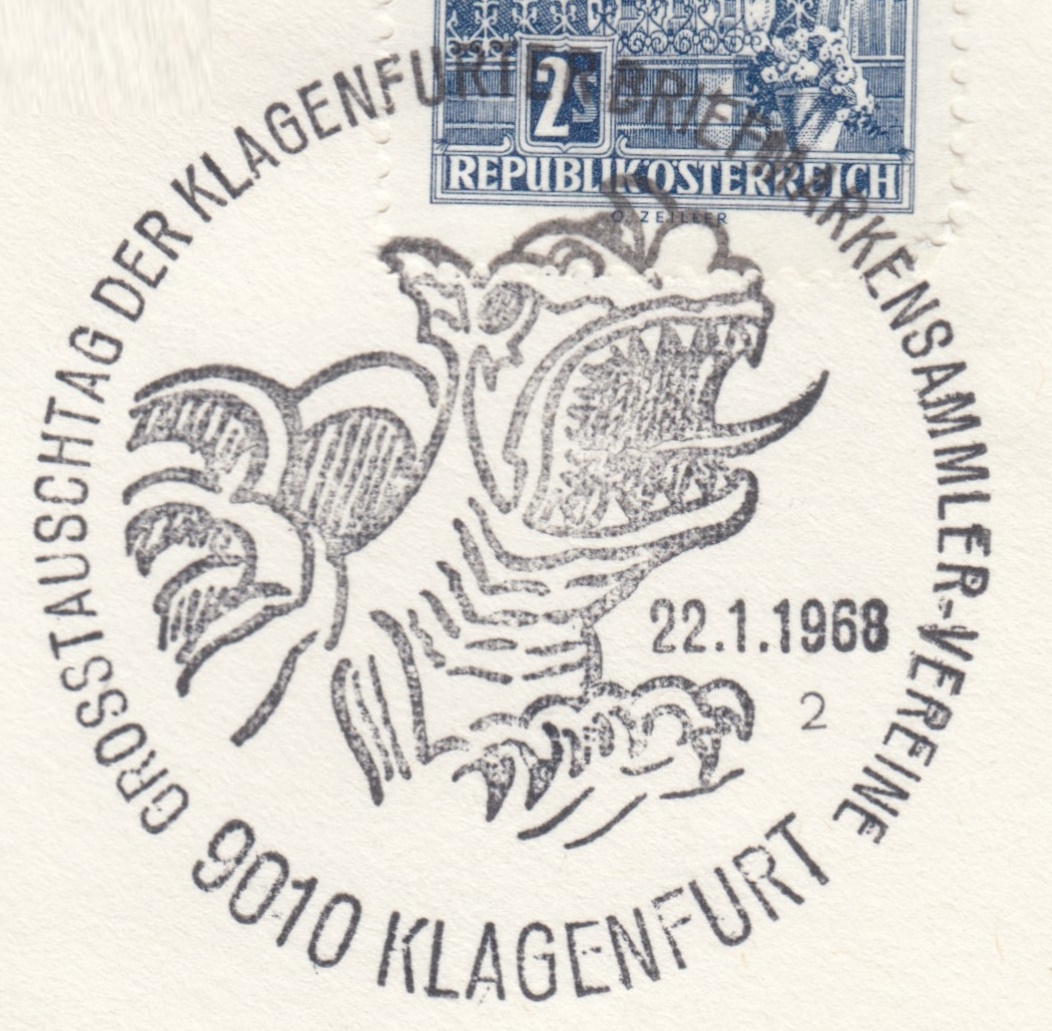 |
| The head of Klagenfurt's dragon sculpture on postmark of Austria 1968. |
The steppe bison or steppe wisent (Bison priscus) is an extinct species of bison. It was widely distributed across the mammoth steppe during the Late Pleistocene.
The mammoth steppe, was once the Earth's most extensive biome.
It spanned from Spain to
Canada and from arctic islands to
China.
The mammoth steppe was cold and dry, and relatively featureless, though topography and
geography varied considerably throughout.
Some areas featured rivers which, through erosion, naturally created gorges, gulleys,
or small glens.
The steppe is known to be flat and expansive grassland.
The vegetation was dominated by palatable, high-productivity grasses, herbs.
Trees and shrubs would have also penetrated to these places, but they were not the
dominate vegetation cover.
Resembling the modern bison species, the steppe bison was over 2 meters tall at the withers, reaching 900 kg in weight. The tips of the horns were a meter apart, the horns themselves being over half a meter long.
During the late Middle Pleistocene, around 195,000-135,000 years ago, the steppe bison migrated across the Bering Land Bridge into North America, becoming ancestral to the endemic North American bison species.
Woolly mammoth, Mammuthus primigenius
The woolly mammoth (Mammuthus primigenius) is an extinct species of mammoth that lived during the Pleistocene until its extinction in the Holocene Epoch.
The word mammoth comes from the Russian mamont, probably in turn from the Vogul (Mansi) language, mang ont, meaning "earth horn".
It was one of the last in a line of mammoth species. The closest extant relative of the woolly mammoth is the Asian Elephant.
Morphological and genetic studies suggest that woolly mammoths evolved from steppe mammoths (Mammuthus trogontherii) between about 800,000 and 600,000 years ago in Asia.
The steppe mammoth (Mammuthus trogontherii) is an extinct species of mammoth
that ranged over most of northern Eurasia during the Early and Middle Pleistocene,
approximately 1.7 million-200,000 years ago.
One of the largest mammoth species, it evolved in East Asia during the Early Pleistocene,
around 1.8 million years ago, before migrating into North America around 1.5 million years
ago, and into Europe during the Early/Middle Pleistocene transition, around 1 to 0.7 million
years ago.
It was the ancestor of the woolly mammoth (Mammuthus primigenius) and
Columbian mammoth (Mammuthus columbi) of the later Pleistocene.
Some very well-preserved remains have led some scientists to think that Mammoths could be brought back to life through genetic manipulation and cloning. If this is the case, then perhaps someday Mammoths could be released into the wild in Siberia.
The woolly mammoth was known for its large size, fur, and imposing tusks. Thriving during the Pleistocene ice ages, woolly mammoths died out after much of their habitat was lost as Earth’s climate warmed in the aftermath of the last ice age. The species is named for the appearance of its long thick coat of fur.
Woolly mammoths stood about 3 to 3.7 meters tall and weighed between 5,500 and 7,300 kg. They had a yellowish-brown undercoat about 2.5 cm thick beneath a coarser outer covering of dark brown hair that grew more than 70 cm long in some individuals. Under the extremely thick skin was a layer of insulating fat at times 8 cm thick.
The woolly mammoth is by far the best-known of all mammoths and the first animal associated with Ice Age by a public. It was depicted the first time on Mongolian stamp in 1967 and it was the second mammoth stamp after a Polish stamp issued the year before.
Mammuthus primigenius is recorded from the northern part of the Republic of Mongolia. In 1998, a joint expedition of the National University of Mongolia and the Khovd branch school of the University discovered the remains of a mammoth (they found 70 percent of its skeleton) in a place named Teserkhii of Buultin Bulag located in Durgun village. Prior to the discovery, paleontologists had no evidence, except some cave paintings, that mammoths wandered the Mongolian steppes. These fossils are stored in the collections of the National Museum of Natural History at Ulaan-Baatar.
Woolly rhinoceros, Coelodonta antiquitatis
The woolly rhinoceros (Coelodonta antiquitatis) is an extinct species of rhinoceros that inhabited northern Europe, North Africa, and Asia, including Mongolia, during the Pleistocene Epoch (2.58 million years ago - 11.700 years ago).
The woolly rhinoceros probably evolved somewhere in north-eastern Asia, entered the European region, and became extinct at the end of the most recent ice age.
Woolly rhinoceroses remained in northern Eurasia until at least 18,500 years ago, and scientific evidence suggests that they were not hunted to extinction by human beings. The closest living relative of Coelodonta is the Sumatran rhinoceros.
The woolly rhinoceros was covered with long, thick hair that allowed it to survive in the extremely cold, harsh mammoth steppe, during the Ice Age. It had a massive hump reaching from its shoulder and fed mainly on herbaceous plants that grew in the steppe. Mummified carcasses preserved in permafrost and many bone remains of woolly rhinoceroses have been found in Siberia, Russia and North America.
Woolly rhinoceros remains have been known long before the species was described and were the basis for some mythical creatures. Native peoples of Siberia believed their horns were the claws of giant birds.
A rhinoceros skull was found in Klagenfurt, Austria, in 1335, and was believed to be that of a dragon.
One of the earliest scientific descriptions of an ancient rhinoceros species was made in 1769, when the naturalist Peter Simon Pallas wrote a report on his expeditions to Siberia where he found a skull and two horns in the permafrost. In 1772, Pallas acquired a head and two legs of a rhinoceros from the locals in Irkutsk.
In 2012, a rhinocerotid skeleton was found in silty sand and gravel beds in a Late Pleistocene alluvial fan at a construction site in Ondorkhaan City (336 km East of Ulaan-Baatar), Khenty Province, eastern Mongolia. The bones (54 skeletal remains) are stored in the Khenty Local Museum in Ondorkhaan.
Many parts of the postcrania of the Mongolian skeleton resemble the postcrania of the woolly rhinoceros from La Fage in France.
Coelodonta antiquitatis was a popular subject for Stone Age painters and sculptors. Images of woolly rhinoceroses are found among cave paintings in Europe and Asia, including the Khoid Tsenkher Cave in Mongolia. The paintings in the cave belongs to the time when the woolly rhinoceros had not yet arrived in Europes.
The East Asian Ostrich, Struthio anderssoni
Struthio anderssoni, also known as the East Asian ostrich, is an extinct species of ostrich that lived in the Pleistocene and Holocene in China and Mongolia.
The ostrich was a component of North Asian Ice Age fauna including woolly mammoth, woolly rhinoceros and bison.
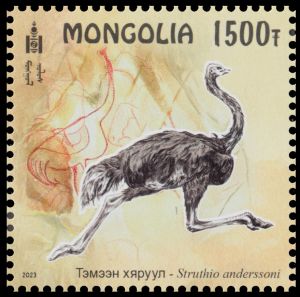 |
| The East Asian Ostrich (Struthio anderssoni) on stamp of Mongolia 2023 MiNr.: , Scott: |
In 2023, based on a re-examination of cast of a femur, it was suggested that this species be moved to the genus Pachystruthio.
Ostriches (Struthionidae) are remarkable giant flightless birds.
The two living African species represent only a small part of ancient struthionid
diversity, which comprises a number of fossil taxa, including the largest known birds
of Northern Hemisphere – Pleistocene giants Pachystruthio,
who has been estimated standing 3.5 meters tall and weighing up to 450 kg.
In comparison with most other birds, ostriches have an extensive fossil record,
mostly represented by eggshell fossils, which are rather common in many Neogene to
Quaternary localities of Africa and Eurasia.
The osteological fossil record is much less representative for Struthionidae and is mainly represented by isolated leg bones. Eggshells of Struthio anderssoni from Late Pleistocene are known from Mongolia and eastern China.
The species Struthio anderssoni was named by Percy Roycroft Lowe (1870 – 1948), a Curator of Birds at the Natural History Museum in London between 1919 and 1935, after Swedish archaeologist, paleontologist and geologist, Dr. Johan Gunnar Andersson, who is closely associated with the beginnings of Chinese archaeology in the 1920s.
The eggs, Lowe used to describe the new species of Struthio genus, were collected by Andersson in China during his expedition, organized by the University of Upsala (Sweden), in 1921.
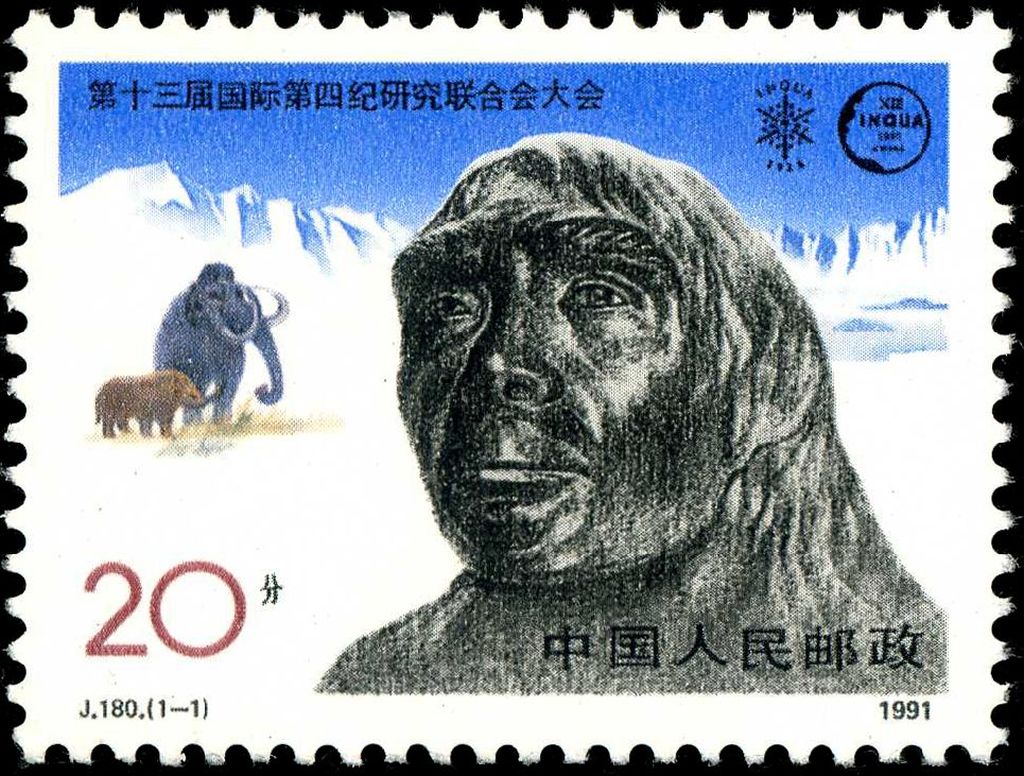 |
| Homo erectus, (Peking man), woolly mammoth and woolly rhinoceros on stamp of China 1991 MiNr.: , Scott: . |
One of the locations were eggshells of the ostrich were
discovered in China is Pleistocene strata at Zhoukoudian site.
The site is known as
"Zhoukoudian Peking Man Site".
The site has yielded the largest known collection of fossils of the extinct hominin
Homo erectus — altogether some 40 incomplete skeletons, which are commonly
known as the Peking Man fossils.
The first finds, two human teeth, of the Peking Man were made by Johan Andersson
during his visit of the site in 1926.
Mammoths and the ostriches appear to have been the last Asian Pleistocene "megafauna" to become extinct. According to recent research, both climate change and human population expansion were contributing factors for the extinction of Struthio anderssoni. In most of the places Struthio anderssoni got extinct 10.000 years ago, but in Southern Mongolia, the ostriches may have persisted for about 7.500 years ago.
Ostrich-like birds are depicted in rock art of the Mongolian rocks and caves in association with rhinoceros, horse, aurochs, and humans.
The images of all four animals, depicted on the "Ice Age Animals" stamps, were painted in the Khoid Tsenkher Cave / Gurban Tsenkher Cave.
The limestone cave located 25 km west of Mankhan soum, Khovd province
1340 km southwest of Ulaanbaatar at an altitude of 1571 m above the sea level.
The cave has two names, both associated with the nearby river Tsenkher:
Gurban Tsenkher Cave and Khoid Tsenkher Cave.
The cave was discovered by a Mongolian geologist Namnandorj,
who had great interest on rock and cave art, in 1950 and it is well
known for its prehistoric cave paintings.
The main chamber is at least 25 meters high and has a floor area of 12 x 18 m.
The cave is not easy to enter because it has numerous tunnels and passages that are up to
200 meters long.
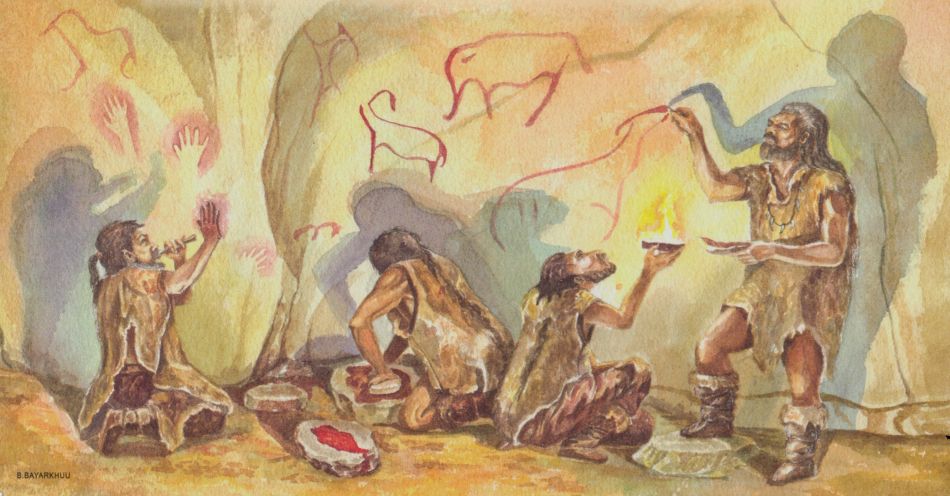
Prehistoric painters on margin of the Mini-Sheet of Mongolia 2023
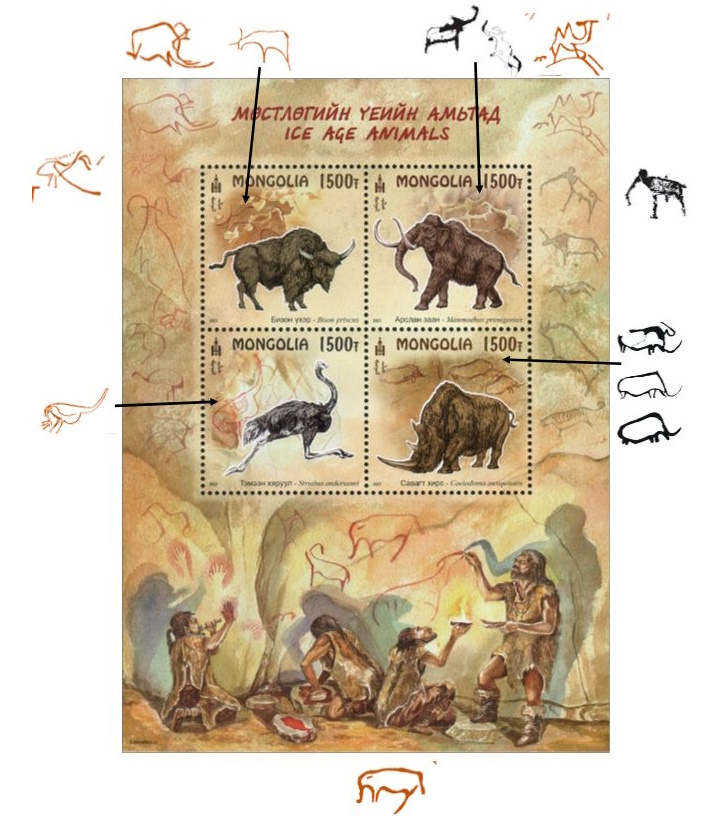 |
| The red and brown paintings are from the cave, the black are petroglyphs from outside. The image was created by the fellow collector Peter Brandhuber from Germany. |
The cave paintings estimated 30.000 - 40.000 years old and are considered the most ancient in Central Asia. The cave paintings were first carved and then drawn on with red or brown ochre and they depict various animals and trees.
Beside the four animals depicted on the stamps, the paintings inside and outside of the cave shows many other animals such as oxen, ibex, antelopes, sheep, camels and lions. Many of these animals are either extinct or are no longer present in today's Mongolia. The animals depicted in the paintings suggest that in the deep past Mongolia had a much warmer climate.
There are also many petroglyphs on the rocks outside of the cave, which may be younger than the pictures inside the cave.
The paintings are stylistically similar to other Paleolithic rock art from around the world, but are unlike any other examples in Mongolia.
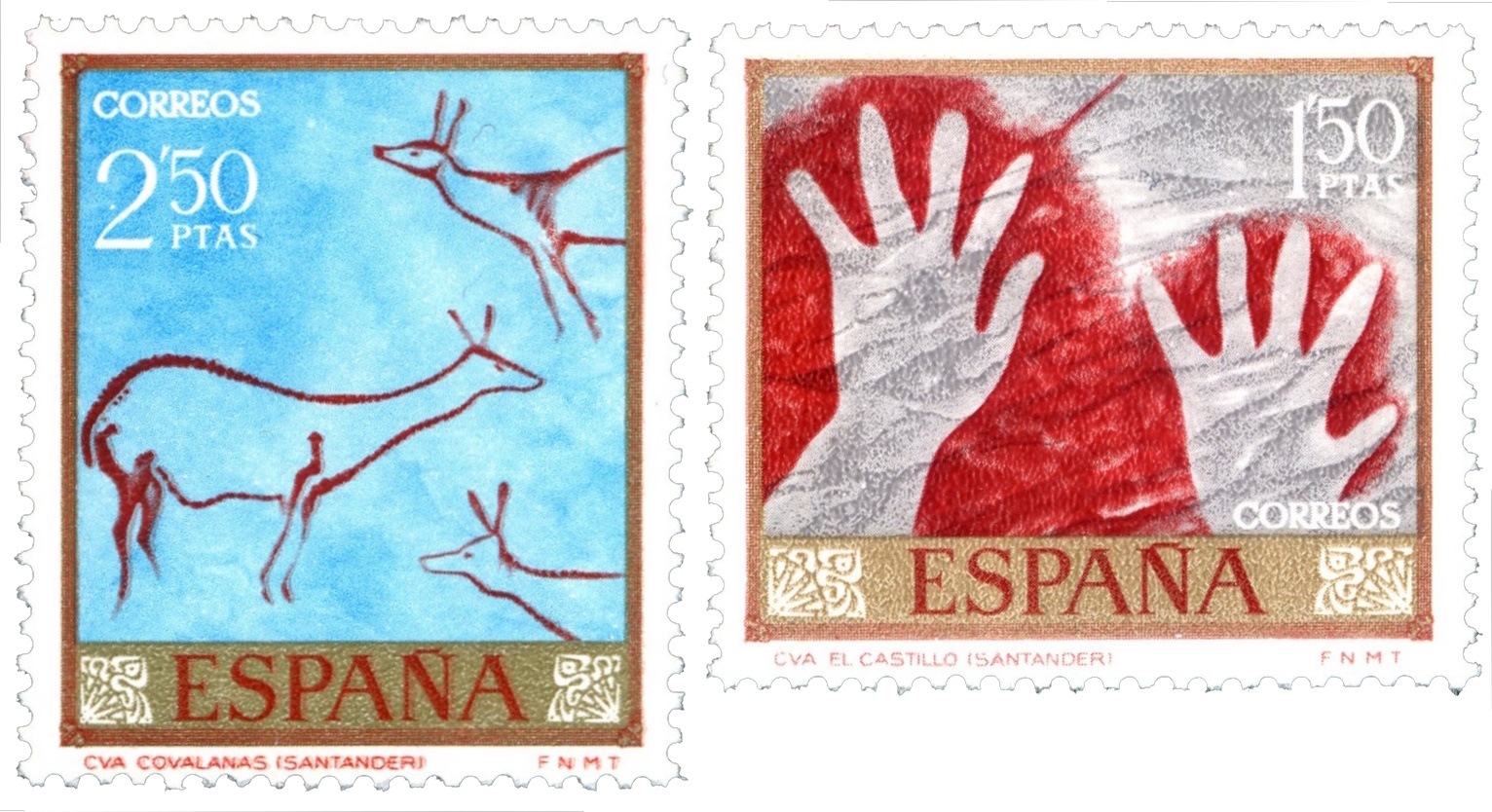 |
| Cave paintings on stamps of Spain 1967, MiNr: 1671, 1669 ; Scott: 1455, 1453 |
In addition to the paintings, some stone tools and fossils of the Ice Age animals were discovered in and near the cave. The most significant is a horn of rhinoceros.
The entrance of the cave depicted on the First-Day-of-Issue Postmark. The ostrich is shown on the left side of the postmark, a mammoth and a rhinoceros shown on the right.
Products and associated philatelic items
| FDC | First-Day-of-Issue Postmark | Imperforate Mini-Sheet |
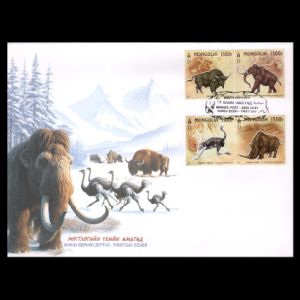 |
 |
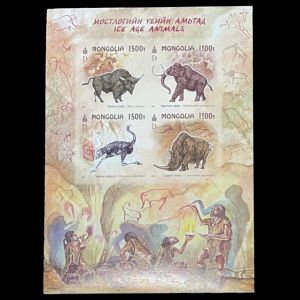 |
| Circulated FDC | Example of Circulated Covers | |
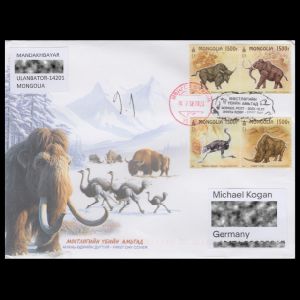 |
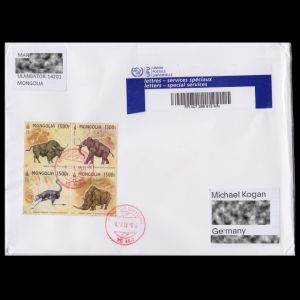 |
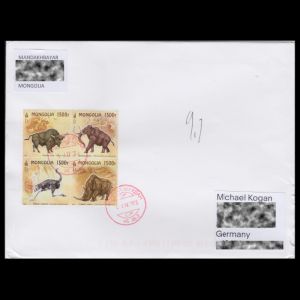 |
References:
- Technical details and stamps presentation:
online store of Mongolian post, Colnect, MONTSAME News Agency. - The steppe bison, Bison priscus:
Wikipedia, Encyclopedia Britannica. - Woolly mammoth, Mammuthus primigenius:
Wikipedia, Encyclopedia Britannica.
"The Padul mammoth finds — On the southernmost record of Mammuthus primigenius in Europe and its southern spread during the Late Pleistocene", by Diego J. Álvarez-Lao, , et. al.-
Steppe_mammoth, Mammuthus trogontherii:
Wikipedia, Science Direct.
-
Steppe_mammoth, Mammuthus trogontherii:
- Woolly rhinoceros, Coelodonta antiquitatis:
Wikipedia, Encyclopedia Britannica.
"The woolly rhinoceros (Coelodonta antiquitatis) from Ondorkhaan, eastern Mongolia", by Handa, N., et. al. - The East Asian ostrich, Struthio anderssoni:
Wikipedia,- "The late Cenozoic history of the ostriches (Aves: Struthionidae), as revealed by fossil eggshell and bone remains" by Konstantin E. Mikhailov and Nikita Zelenkov.
- "Dating North Asian surface assemblages with ostrich eggshell: implications for palaeoecology and extirpation", by Lisa Janz, , et. al. .
- "Struthious remains from China and Mongolia : with descriptions of Struthio wimani, Struthio anderssoni and Struthio mongolicus, spp. nov." by Percy Roycroft Lowe. Published in Palaeontologia Sinica, Series C. 6: 1–47. in 1931.
- Pachystruthio:
Wikipedia,
- Percy Lowe:
Wikipedia,
- Johan Gunnar Andersson:
Wikipedia
- The Khoid Tsenkher / Gurban Tsenkher Cave:
Wikipedia, Tourist info center of Mongolia, Mongolia Travel Guide, Escape to Mongolia, View Мongolia, Siberian Times, The Past.
- "Hunting, herding, and people in the rock art of Mongolia: New discoveries in the Gobi-Altai Mountains." by Nils VANWEZER, et. al.
- "Archaeological and environmental cave records in the Gobi-Altai Mountains, Mongolia", by Nils Vanwezer, et. al.
Acknowledgements:
- Many thanks to Dr. Peter Voice from Department of Geological and Environmental Sciences, Western Michigan University, for the draft page review and his valuable comments.
- Many thanks to fellow collector Peter Brandhuber from Germany, who runs the "Evolution of mankind and Philately" facebook group, for his help finding information about animals depicted on the stamps and the cave with the cave art.
| <prev | back to index | next> |